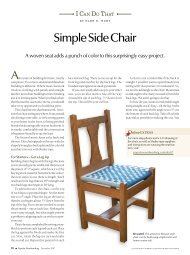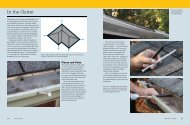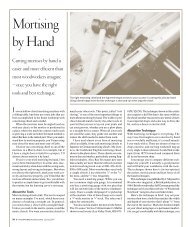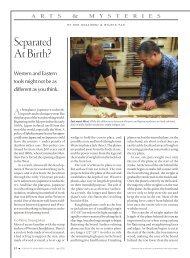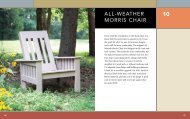Classic Shaker Side Table - Popular Woodworking Magazine
Classic Shaker Side Table - Popular Woodworking Magazine
Classic Shaker Side Table - Popular Woodworking Magazine
You also want an ePaper? Increase the reach of your titles
YUMPU automatically turns print PDFs into web optimized ePapers that Google loves.
WOODWORKINM AG A Z I N ECutting bevelor BezelG2 Common TypesChisels Autumn 2004Cutting with the tool Perpendicularor at an Angle to the WorkThe most important consideration is to positionyourself so you can see the profile of the tooland determine if it is indeedat 90° to your work.Common Chiseling TechniquesParing with the FaceFlat Against the WorkWhen paring, it's typically best to use onehand to steer the blade and the other to pushthe tool into the cut. This gives you controland power.Face or Back(opposite side)BladePushinghandPushinghandBevel EdgeNeckUse the cutting edge to define your layout linesbefore removing wasteinside them.SteeringhandSteeringhandBolsterTangSocketScrapingHold tool as shown below and pull towardyou with firm downward pressure. Scrapingis an excellent technique for cleaning uphand-cut joints, such as tenons and rabbets.Bevel-edge ChiselLong edges are groundat an angle to allowthe tool to get intotight spaces, such asbetween dovetails. Notdesigned for heavychopping. commonvariant is the paringchisel, which has alonger, thinner blade.FerruleHandleMortising ChiselThick blade allows thetool to be driven witha mallet and to leverout waste in mortises.One variant is thefirmer chisel, which hasa thick blade — thoughnot as thick as amortising chisel — andis designed for heavierwork. The butt chisel,another commonvariant, is typically afirmer chisel but witha much shorter blade.Useful Chisel SizesFirst Buy a set of fiveBevel-edge Chisels:1/8" – Invaluable for cleaningout waste in tight spacesbetween dovetails.1/4" – Many grooves in frameand-panelwork are ¬" wide, sothis is an ideal size to use toclean them up.3/8":– Mortises in œ"material are typically ¬"or µ" wide, so the µ" chiselis useful for cleaning outcorners and waste.1/2":– Good for cleaning outhinge mortises.3/4":– Good for paring andsome scraping.Then Buy:5/16" bevel-edge:– If yourwork uses π"-thick material,this will prove useful forcleaning out mortises.5/8" + 7 /8" bevel-edge:–Intermediate sizes for hingemortises, paring and scraping.1/4" + 3 /8" mortising:–If you're a hand-toolwoodworker, these two sizeswill handle most of yourmortising needs.Common Sharpening Angles20° Bevelparing only20° 25° 30°-35°25° Bevelgeneral purpose,paring and lightchopping30° to 35°Bevelmortising andheavy choppingIllustration by Matt Bantly



